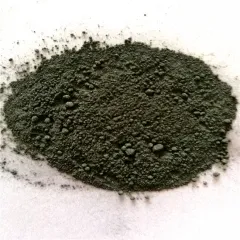- Home
- Products
- Elementary
- Boride Powder
- 3D Printing Powder
- Sulfide Powder
- Oxide Powder
- Carbide powder
- Nitride Powder
- Silicide Powder
- Hydride Powder
- Telluride Powder
- Selenide Powder
- Stearic Acid Series
- Phosphide Powder
- Nanoparticles
- Metal Alloy
- MAX Phase
- Lithium Battery Anode
- Surfactant
- Molecular sieves
- Concrete Admixtures
- Cladding of metals
- News
- Blog
- Contact
- About
Synthesis and Properties of Nickel Oxide Nanomaterials
Synthesis of nickel oxide nanomaterials:
Sol-gel method
The sol-gel method is a standard method for preparing nickel oxide nanomaterials. Mix nickel nitrate and ethanol, add the appropriate amount of deionized water, and stir evenly to form sol. Then, the sol is dried under constant temperature conditions to obtain a gel. Finally, the gel was heat treated at a high temperature to obtain nickel oxide nanoparticles.
Chemical vapor deposition method
Chemical vapor deposition (CVD) directly synthesizes nanomaterials through gaseous precursors at high temperatures. The solution was formed by mixing nickel nitrate and ethanol, adding an appropriate amount of deionized water, and stirring evenly. Then, the solution is evaporated at high temperatures to obtain a gaseous precursor. Nickel oxide nanowires were obtained by chemical vapor deposition (CVD) at high temperatures by passing the gaseous precursor into the reactor. The advantages of this method are that the product has a high aspect ratio and orientation.
Microemulsion method
The microemulsion method is a method of preparing nanomaterials by microemulsion system. Mix nickel nitrate and ethanol, add an appropriate amount of deionized water, and stir evenly to form a microemulsion. Then, the microemulsion was evaporated under constant temperature to obtain nickel oxide nanorods. The advantages of this method are that the product has a high length-diameter ratio and uniformity.
Other synthesis methods
In addition to the above methods, several other synthesis methods have also been used to prepare nickel oxide nanomaterials. For example, ultrasonic chemistry can reduce metal ions in solution to metal nanoparticles by ultrasonic cavitation. The electrochemical deposition method can deposit Ni oxide nano-films on the electrode by electrochemical reaction. Molecular beam epitaxy can grow nickel oxide nanostructures on a single crystal substrate. Each method has its advantages and disadvantages and is suitable for different application scenarios.

Characterization of nickel oxide nanomaterials:
Morphology characterization
Morphology characterization is the basis of the study of nickel oxide nanomaterials. SEM and TEM can clearly show ni oxide nanomaterials' shape, size, and dispersion. In addition, high-resolution TEM can further observe the crystal structure and lattice fringes of nanomaterials.
Structural characterization
Structure characterization is an integral part of the study of nickel oxide nanomaterials, and the commonly used structure characterization methods include X-ray diffraction (XRD) and Raman spectroscopy. The crystal structure and phase composition of nickel oxide nanomaterials can be determined by XRD analysis, and their crystallographic properties can be further understood.
Component analysis
The commonly used composition analysis methods include energy dispersive analysis (EDS) and X-ray photoelectron spectroscopy (XPS). The content and distribution of elements in Ni oxide nanomaterials can be determined by EDS analysis. XPS can provide information about the chemical state of elements on the surface of nickel oxide nanomaterials and help analyze their surface properties and chemical reactions.
Performance test
Properties testing is an essential step in the study of nickel oxide nanomaterials. The commonly used properties testing methods include electrochemical properties testing, catalytic properties testing and photoelectric properties testing. Electrochemical performance testing can explain the electrochemical performance of Ni oxide nanomaterials in batteries, supercapacitors and other fields. Catalytic performance tests can evaluate the activity and selectivity of nickel oxide nanomaterials in catalytic reactions. The photoelectric performance test can study the application performance of nickel oxide nanomaterials in photoelectric conversion, photocatalysis and other fields.

Study on properties of nickel oxide nanomaterials:
Catalytic performance
Nickel oxide nanomaterials have excellent performance in catalysis. Because of its high specific surface area and abundant active sites, it shows high activity and selectivity in catalytic reactions. For example, in organic synthesis reactions, nickel oxide nanomaterials can be used as catalysts to promote the reaction and improve the yield and selectivity of products. In addition, in environmental protection, nickel oxide nanomaterials can also be used as a catalyst for waste gas treatment, water pollution control and other aspects, showing good catalytic oxidation performance.
Photoelectric performance
Nickel oxide nanomaterials also show excellent properties in the field of optoelectronics. Because of its wide band gap and high light absorption coefficient, it has potential application value in photoelectric conversion and photocatalysis. For example, in solar cells, nickel oxide nanomaterials can be used as photoanode materials to improve the photoelectric conversion efficiency of the battery. In addition, in the field of photocatalysis, nickel oxide nanomaterials can be used as photocatalysts to drive chemical reactions using light energy to achieve the degradation of organic pollutants and the effective use of resources.
Sensing performance
Nickel oxide nanomaterials also show excellent properties in the field of sensing. Because of its high specific surface area and sensitive surface activity, it has potential application value in gas sensing and biosensing. For example, in gas sensors, nickel oxide nanomaterials can be used as sensitive elements to rapidly and accurately detect target gases. In addition, in biosensors, nickel oxide nanomaterials can be used as recognition elements of biomolecules to achieve high sensitivity and high selectivity detection of biomolecules.
Other performance
In addition to the above properties, nickel oxide nanomaterials have some other unique properties. In addition, nickel oxide nanomaterials also have excellent magnetic and mechanical properties, which allow their application in more fields.
Nickel Oxide NiO Pulver Storage Conditions:
Nickel Oxide NiO Powder needs to be kept cool in a ventilated place. It should be kept away from heat and flames. It would help to keep it separate from any acids or edible chemicals. Mixing is not recommended. The storage space should have adequate materials to stop leakage.
Shipping and Packing of Nickel Oxide NiO Pulp:
You can pack it in two plastic bags with the inside.
Nickel Oxide NiO Powder Packaging: 100g, 500g and 1kg/bag. 25kg/barrel. Or as you request.
Nickel Oxide NiO Powder Shipping: Send-outs could be made by sea or air as soon as payment receipt.
Synthetic Chemical Nano Technology Co. Ltd. has over 12 years of experience as a supplier and manufacturer of super high-quality chemical material. This includes boride, nitride, graphite, sulfide, 3D printing powders, and more.
High-quality products are what you want: nickel oxide powder. Please feel free to contact us to enquire. (sales5@nanotrun.com)
Inquiry us